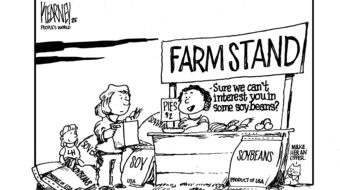The president introduced his job plan in a speech to Congress Sept. 8, and introduced the American Jobs Act (AJA) a few days later. It includes $450 billion over one year, a higher spending rate than the two-year ARRA (original stimulus), which was less than $400 billion per year. Obama has been speaking around the country, urging people to demand that Congress “pass this bill” to meet the ongoing jobs crisis and to meet real social and economic needs.
In another article, I put the president’s bill in the context of the present political and economic situation in the country. Here, I will examine in more detail what is actually in the bill.
The Good Stuff
About $190 billion represents a needed down-payment on creating jobs and meeting necessary social and economic needs. This includes:
* $105 billion for infrastructure. This is targeted at programs that can get off the ground quickly. $50 billion for transportation, $30 billion for schools, $15 billion to rehab foreclosed homes, $10 billion for a national infrastructure bank. The infrastructure bank is meant to somehow leverage private funds, ultimately producing a lot more than $10 billion worth of projects. At best, that will take a while to get off the ground. To put the whole $100 billion in context: the U.S. needs to spend almost $500 billion/year for five years just to bring existing infrastructure into good repair and working order.
* $49 billion extension of unemployment benefits. This is really important, maintaining a lifeline for millions of families. But it provides no new help or stimulus, simply continuing the existing program.
* $35 billion for teachers and first responders. This is vital, both for the services they provide and the boost to struggling local budgets. But state budgets alone are facing a shortfall over $100 billion, and local governments are facing bigger budget problems every year.
* $5 billion for “Pathways to Work”, which restores programs that were cut in 2011, and in 2009-2010 supported over 370,000 jobs for youth and low-income unemployed. (About 1.5 million jobs for teenagers alone have been lost in this recession). Pathways to Work also includes some good initiatives to promote work-sharing, hiring long-term unemployed, veterans, and other particularly hard-hit groups. These will help some individuals, but are unlikely to have a broad impact within these groups in absence of more direct employment programs.
Payroll tax cut
The president proposes extending the existing payroll tax cut and increasing it from 2 percent to 3.1 percent. At $175 billion, this is largest single part of Obama’s proposal. Extending the existing 2 percent tax cut prevents a significant cut in workers’ pay, and prevents a significant withdrawal of purchasing power from the economy, and consequent loss of up to a high estimate of 1 million jobs. The proposed additional cut provides another small boost to paychecks ($5/week for a worker making $12.50/hour or $25,000/year), stimulating the creation of as many as 500,000 jobs.
Tax cuts are a relatively ineffective way to stimulate the economy. And while this tax cut goes almost entirely to working people, it is weighted toward upper-income working people. Being based on payroll, the more you get paid the bigger your tax cut (up to a salary of $107,000/year). And low-income families are more likely to be without jobs, or on pensions, in which case they don’t pay payroll tax so they don’t get any benefit. The result: those with incomes under $62,000/year make up 60 percent of the population, but receive only 31 percent of the benefits. On the other hand, the 20 percent of families with incomes over $104,000 – families who are more likely to save than spend their windfall – get a whopping 42 percent of the funds. This weakens both the social benefits (helping working families who are in real need) and the economic stimulus. Some argue that the payroll tax cut makes political attacks on Social Security easier, but this is not true.
Business tax cuts
The AJA includes $70 billion in business tax cuts. These include cutting the payroll tax in half for all employers for the first $5 million in wages — in effect, a general tax cut for small and medium businesses. Also extending 100 percent expensing of investments for another year. Also included are various tax credits and incentives for hiring new workers, and especially for hiring unemployed veterans.
These measures will do little for jobs or the economy. Businesses will expand and hire more workers if and only if there is an increase in demand for their product. They will be glad to take the money that is offered. There are always some companies that are hiring while others are laying off. Those that are hiring will be happy to get the tax credit for hiring new workers. But the offer of a tax credit will not convince them to hire workers they don’t need.
As Motoko Rich reports in the New York Times, “The dismal state of the economy is the main reason many companies are reluctant to hire workers, and few executives are saying that President Obama’s jobs plan – while welcome – will change their minds any time soon. “
Foreclosure Crisis
Obama said he would “work with federal housing agencies to help more people refinance their mortgages” at low interest rates. This would be welcome for the estimated 110,000 homeowners that would be helped, but will leave millions out and have no significant effect on the housing market or the economy.
Paying for the Plan
Obama did not provide immediate details, but his proposal is certain to include closing some loopholes enjoyed by corporations and the wealthy. This approach is reasonable, popular, and necessary. But President Obama may also be opening the door to cut Medicare and, perhaps, Social Security – that would be an economic and political disaster.
Conclusion
The plan, optimistically, would add 2 million jobs over the next year – enough to reduce the unemployment rate by a bit more than 1 percent. But 12 to 15 million new jobs are needed just to get us back to where we were before the crisis struck in 2008. The plan continues the present unemployment coverage for long-term unemployed, but does nothing for the many millions who have exhausted even their extended coverage, or those, including the majority of youth, who have never had a steady job long enough to qualify. The plan restores $5 billion in programs to that employed 370,000 youth and low-income unemployed during 2009 and 2010 – with five to ten times that many needing jobs. The plan barely begins to address the challenges the president posed, of “bridges across this country that need rebuilding” and “great school” for every child.
But Obama’s AJA is a 180-degree change in direction from the cut-spending, cut-jobs, cut-healthcare, damn-the-environment, outlaw-unions, you’re-on-your-own right-wing, corporate agenda that has dominated Congress since Republicans took control of the House last year. From labor leaders to progressive organizations to the Congressional Progresive caucus, the response is similar: Obama’s plan is better than we expected, and although it does not do enough, it should be supported while pushing for more/better proposals.










